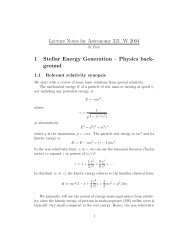Lecture Notes for Analog Electronics - The Electronic Universe ...
Lecture Notes for Analog Electronics - The Electronic Universe ...
Lecture Notes for Analog Electronics - The Electronic Universe ...
You also want an ePaper? Increase the reach of your titles
YUMPU automatically turns print PDFs into web optimized ePapers that Google loves.
Thus, we should try to keep the ratio RTH/RL small in order to approximate ideal behavior<br />
and avoid “loading the circuit”. A maximum ratio of 1/10 is often used as a design rule of<br />
thumb.<br />
A good power supply will have a very small RTH, typically much less than an ohm. For<br />
a battery this is referred to as its internal resistance. <strong>The</strong> dimming of one’s car headlights<br />
when the starter is engaged is a measure of the internal resistance of the car battery.<br />
1.5.2 Input and Output Impedance<br />
Our simple example can also be used to illustrate the important concepts of input and output<br />
resistance. (Shortly, we will generalize our discussion and substitute the term “impedance”<br />
<strong>for</strong> resistance. We can get a head start by using the common terms “input impedance” and<br />
“output impedance” at this point.)<br />
• <strong>The</strong> output impedance of circuit A is simply its <strong>The</strong>venin equivalent resistance RTH.<br />
<strong>The</strong> output impedance is sometimes called “source impedance”.<br />
• <strong>The</strong> input impedance of circuit B is its resistance to ground from the circuit input. In<br />
this case it is simply RL.<br />
It is generally possible to reduce two complicated circuits, which are connected to each<br />
other as an input/output pair, to an equivalent circuit like our example. <strong>The</strong> input and<br />
output impedances can then be measured using the simple voltage divider equations.<br />
2 RC Circuits in Time Domain<br />
2.0.3 Capacitors<br />
Capacitors typically consist of two electrodes separated by a non-conducting gap. <strong>The</strong><br />
quantitiy capacitance C is related to the charge on the electrodes (+Q on one and −Q on<br />
the other) and the voltage difference across the capacitor by<br />
C = Q/VC<br />
Capacitance is a purely geometric quantity. For example, <strong>for</strong> two planar parallel electrodes<br />
each of area A and separated by a vacuum gap d, the capacitance is (ignoring fringe fields)<br />
C = ɛ0A/d, whereɛ0 is the permittivity of vacuum. If a dielectric having dielectric constant<br />
κ is placed in the gap, then ɛ0 → κɛ0 ≡ ɛ. <strong>The</strong> SI unit of capacitance is the Farad. Typical<br />
laboratory capacitors range from ∼ 1pF to ∼ 1µF.<br />
For DC voltages, no current passes through a capacitor. It “blocks DC”. When a time<br />
varying potential is applied, we can differentiate our defining expression above to get<br />
I = C dVC<br />
dt<br />
<strong>for</strong> the current passing through the capacitor.<br />
6<br />
(1)













